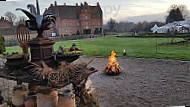Imagini
ContribuieRezervă acum
Recenzii
Contribuiți la feedbackBeautiful nature and a very nice and well maintained monastery... absolutely a visit they also have an orangeri with the cafe and store where you can buy div. flowers and things with floral motifs
Very beautiful place to visit. We were there in connection with the annual Lifestyle Fair. Do not enter the Klosteret (slot/gods). But in the park, on the farm and in the old barn area. You can walk around the lake.
Cool sunny day in April. Really beautiful surroundings, good inspirational source. Coming back when several flowers jump out.
Denmark’s most beautiful park. Beautiful forest lakes, many different big trees and bushes. Beautiful old orangeri. Very well maintained buildings.
Beautiful little castle, fantastic park. Gisselfeld, located between Haslev and Rønnede, is one of Denmark’s largest estates with an area of 4,000 hectares with Hesede, Edelesminde, Breadebæk and Gødstrupgård, of which 2,400 hectares are forest. It is located in several municipalities, but the main court is located in Bråby Sogn in Faxe Municipality. Gisselfeld Kloster (formal Gisselfeld Adlig Virgins in Zealand) is a founder of Zealand. The foundation was established by the willical provision of Christian V 's illegitime son with Sophie Amalie Moth, Christian Gyldenløve in 1701-1702. The provision entered into force by his widow's death in 1754. The foundation is not a monastery in the traditional sense, but a so-called virgins. They described monasterydams – conventuals on Gisselfeld – should be ugten and by the nobles, but they had in contrast with Vallø and Vemmetofte not home on the monastery itself. Instead, they receive an annual withdrawal. Gisselfeld Kloster is led by an over director who, according to the original find, is appointed among males, Countable members of the genus Danneskiold-Samsøe. However, the sex discriminating in the foundat is known invalid in the Danish Gender Equality Act. Gisselfeld's director since 2010 Helene Danneskiold-Samsøe, has a private residence in the main building of the monastery (the castle).
Meniu complet
Mai multe informații
Link cu cod QR către meniu













